Antietam faces, artillery edition
9 May 2019
Lieutenant Evan Thomas commanded the consolidated Batteries A and C of the 4th United States Artillery on the Maryland Campaign.
He was the 3rd son of US Army Colonel and Adjutant General Lorenzo Thomas (USMA 1823), and at the start of the War in April 1861 received a commission as 2nd Lieutenant, 4th United States Artillery. He was promoted to First Lieutenant in May. He was then just 17 years old.
He was assigned to Battery C which, due to a manpower shortage, was consolidated with Battery A in October 1861. He was in action with his battery on the Peninsula in mid-1862 and succeeded to command by order of seniority sometime after Captain Hazzard died of wounds in mid-August 1862. Evan had just celebrated his 19th birthday.
Here’s Lieutenant Thomas with a group of his fellow officers taken at Sharpsburg in September or October 1862, shortly after the battle of Antietam:
The caption on the picture is Lt. Rufus King, Lt. Alonzo Cushing, Lt. Evan Thomas and three other artillery officers in front of tent, Antietam, Md. (click to enlarge) There is no guide to who is who, but I have had some expert help working to identify them.
Jim Rosebrock, noted Antietam artillery man, posits that the photograph is of officers of Batteries A and C, and possibly B, of the 4th US, and notes that there were 5 officers of A&C at Antietam. These were First Lieutenants Evan Thomas (C), Alonzo Cushing (A, attached to McClellan’s staff), and Rufus King (A), along with 2nd Lieutenants Arthur Morris (A) and Edward Field (C). Battery B was commanded by Captain Joseph Campbell, who was wounded at Antietam, and then First Lieutenant James “Jock” Stewart. So Stewart could be the sixth man in the group picture.
Here’s what we have so far:
Number 1 is unknown. He looks a bit like Rufus King, but I’m inclined toward #5 for King. He’s a little young, probably, to be James Stewart, but is similar in appearance. Those shoulder boards/knots are a bit of a mystery, too.
He could be 21 year old 2nd Lieutenant Edward Field, somewhat by process of elimination. Field was son of New Jersey Senator Richard S. Field (1862-63) and an 1861 Princeton graduate, 21 years old at Antietam. Here’s his father, the Senator, by way of possible reference.
Number 2 is Alonzo Cushing. He has a distinctive face and is identified in several other wartime photographs. He was an aide to General McClellan at Antietam. You’ll remember Cushing was killed in action at Gettysburg and was fairly recently awarded the Medal of Honor for his bravery there.
Number 3 is probably 18 year old 2nd Lieutenant Arthur Morris, Battery A. Jim Rosebrock kindly provided the following image of Morris, much later in life, which helps with identification.
Number 4 is Evan Thomas. Here’s a nice photograph of him Jim found for us, if there was any doubt about that very young looking First Lieutenant.
Number 5 is Rufus King, Jr, I think. He was of Battery A, 4th US Artillery, and served in the consolidated battery with Thomas at Antietam. His father the Brigadier General commanded the First Division, First Army Corps at the start of the Maryland Campaign. Here is Rufus, Jr., from a group photo taken in Culpeper, VA in September 1863:
Number 6 is unknown. Some of my correspondents like him as 2nd Lieutenant Edward Field, but this man is wearing First Lieutenant’s shoulder straps. Field was brevetted (honorary rank) First Lieutenant in June 1862, but I wouldn’t expect that he wore the bars until he was commissioned First Lieutenant in August 1863.
Here are some replica artillery officers’ shoulder straps for reference; 2nd and 1st Lieutenant, respectively.
I welcome any additional help in firming up these identifications and solving the remaining mysteries – please feel free to comment below.
__________________________________________
Evan Thomas at Antietam and beyond
Thomas’ battery was attached to Sedgwick’s Division of the 2nd Army Corps on the Maryland Campaign of 1862, and was equipped with 6 smooth bore Model 1857 12-pounder gun-howitzers, better known as Napoleons.
About mid-day on 17 September 1862 at Antietam, his battery moved out of the East Woods and relieved George Woodruff’s Battery (I, First US Artillery) posted along the Smoketown Road south of the Miller cornfield. Sometime later they helped stop the Confederates who were driving the advance elements of General Greene’s Division from the West Woods:
I then changed front to fire to the left, and opened on the advancing enemy with spherical case, and then, as they approached nearer, with canister. They came on, and I would undoubtedly have lost my battery had not Franklin’s column come up at that time. I then changed to my original front, and opened with solid shot on a battery to my right, in the opposite woods, which was soon silenced. Another battery opened on me, which I saw was out of my range. A rifled battery coming up at that time, and seeing I could do no good and was only losing horses for nothing, I deemed it prudent to withdraw. I was shortly afterward ordered to the rear, to fill up …
Here’s that part of the field at about 10:30 AM (click to enlarge) …
… and the battlefield historical tablet for his unit:
It looks like he did excellent work, especially considering his youth. He proved to be a fine artillerist on other fields through the war, too, notably at Fredericksburg in December and at Gettysburg in July 1863. He was honored by brevets to Captain and Major for his actions there.
Thomas was promoted to Captain, USA in August 1864 and served out the War with his Battery.
Captain Thomas, c. 1870
He continued in Regular Army service after the War until he was killed in combat with Modoc warriors in the Lava Beds, California in 1873:
On April 26, Captain Evan Thomas commanding five officers, sixty-six troops and fourteen Warm Spring Scouts left Gillem’s camp on a reconnaissance of the lava beds to locate the Modoc. While eating lunch at the base of Sand (now Hadin) Butte, in a flat area surrounded by ridges, Captain Thomas and his party were attacked by 22 Modoc led by Scarfaced Charley. Some of the troops fled in disorder. Those who remained to fight were either killed or wounded. Casualties included four officers killed and two wounded, one dying within a few days, and thirteen enlisted men killed and sixteen wounded.
Captain Evan Thomas, Company A, Fourth Artillery: rifle ball shots through lower part right forearm and upper part right thigh, cutting the femoral artery. Died on the field.
He was not yet 30 years old.
Originally buried in Washington, DC, he was moved to Arlington in 1899.
_______________________________
Notes
Thanks to Jim Buchanan [Walking the West Woods] for poking me about Lieutenant Thomas and prompting me to show you his photograph.
When I first published this post I knew Lieutenants Cushing and King, and had narrowed Thomas down to either #4 or #6, but knew nothing about the others. I’ve since updated it with their identities.
Thanks to Jim Rosebrock [Antietam Guides, South from the North Woods, Antietam Voices] for the sleuthing to help identify Evan and the other “unknown” men in the group, and for bio details for Edward Field.
Thanks also to Sharon Murray [The Epitaph: Tombstones, Mausoleums, Monuments and Memorials to Civil War Soldiers] for her contributions on the appearance of Lieutenants Stewart and King.
The complete photograph of the 6 artillery officers at Antietam is at the Library of Congress, as are other group photos from which I took the snippets of Cushing and King.
Senator Field’s photo from the U.S. Senate Historical Office, accompanying his Congressional Biography.
See Evan Thomas’ page on Antietam on the Web (AotW) for further details and biographical sources. The map, based on a 1908 map from the Antietam Battlefield Board, is one of the battle set at AotW. Cushing, King, Morris, Field, and Stewart also have pages on AotW.
The first quote above is from Lt. Thomas’ Official Report of 24 September 1862.
The quote about the Modoc action from his Arlington Cemetery page.
His c. 1870 picture is from Erwin Thompson’s MODOC WAR: Its Military History & Topography (1971, online from Lava Beds NM). See Chapter 7 of that work for much more about the action in which Evan Thomas died.
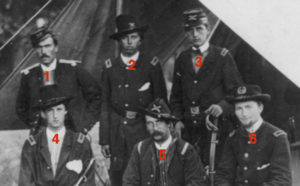
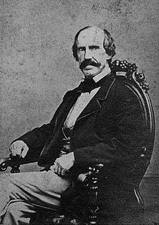
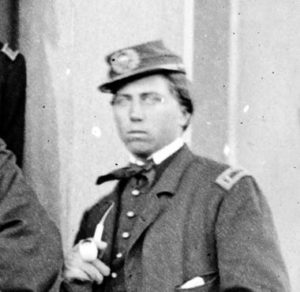
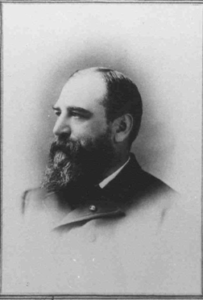
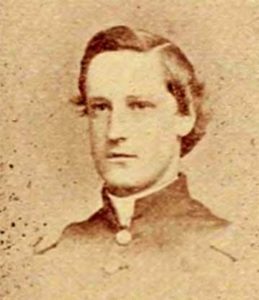
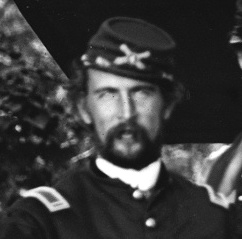

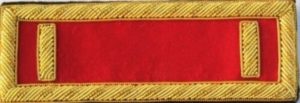
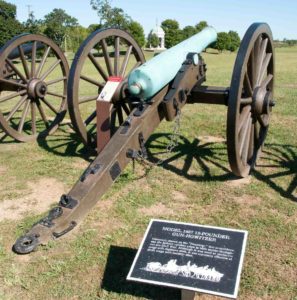
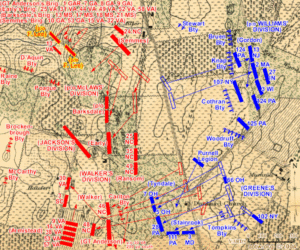
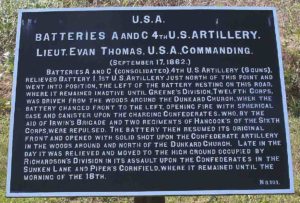


May 12th, 2019 at 2:42 am
It appears that #6 in the image is wearing a Staff Officer’s insignia on his pork pie hat. It may be easier to track him down through staff than through any artillery connection he may have. It’s just a thought.
May 12th, 2019 at 8:57 pm
Thank you, Mark! Do you mean Regular (rather than Volunteer) Army Staff? That would certainly narrow it down.
Added: US Staff Officer hat badge

May 15th, 2019 at 7:41 am
Hasn’t Number 6 been identified as James Rorty in the past?
May 15th, 2019 at 11:53 am
Thanks Bob – nice catch. I see several places online that have him as that man. I’m not sure who made the original identification. The NY Adjutant General says Rorty was promoted to First Lieutenant 31 October 1862 – about the time of this photo, or a little later. I don’t know what connection he had with the other officers in the photograph, but he was probably present at Antietam on Gen Richardson’s staff. I need to look into Lt Rorty …
May 15th, 2019 at 3:51 pm
Update re: Lt Rorty: here’s a drawing of Rorty from Brian Pohanka’s 1993 monograph on him (http://www.69thnysv.org/documents/rorty.pdf). I don’t know it’s source, but it looks like a period engraving for print.
I don’t think he looks much like our man #6.
Harry Smeltzer is working with a photograph of 3 Irish officers, authentication in progress, not confirmed. One of them, identified as Rorty, looks rather like Pohanka’s sketch.
Also, Rorty was promoted to First Lieutenant on 9 December 1862 to date from 31 October. It’s more doubtful now, to me, that he would have been wearing those bars at Antietam.
To make this muddier though, Rorty was associated with Battery C, 4th US Artillery. His section of 2 guns – formerly part of the 2nd Battalion, NY Light Artillery – was attached to “C” on 26 May 1862, though Rorty was assigned as Ordnance Officer to General Richardson’s Division, 2nd Army Corps two days later – the role he had at Antietam.